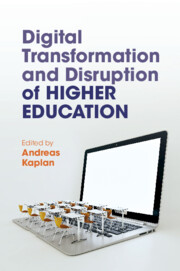Book contents
- Digital Transformation and Disruption of Higher Education
- Digital Transformation and Disruption of Higher Education
- Copyright page
- Contents
- Figures
- Tables
- Contributors
- Preface
- Chapter 1 Nothing Is Constant Except Change
- Part I (R)evolution of the Higher Education Sector
- Part II Changes in Teaching Formats
- Part III Changes in Teaching Content
- Part IV Networking and Social Activities
- Chapter 16 Working Adults’ Networking and Social Activities in Lifelong Learning
- Chapter 17 Students’ Social Networks in a Digitalised and Multicultural World
- Chapter 18 Universities’ Online Networking Operations
- Part V Certification and Diplomas
- Part VI Careers and Professionalisation
- Part VII Futuristic and Ultramodern Higher Education
- Part VIII Higher Education in Motion
- Editor’s Biography
- Index
- References
Chapter 18 - Universities’ Online Networking Operations
Expectations and Perceptions
from Part IV - Networking and Social Activities
Published online by Cambridge University Press: 09 June 2022
- Digital Transformation and Disruption of Higher Education
- Digital Transformation and Disruption of Higher Education
- Copyright page
- Contents
- Figures
- Tables
- Contributors
- Preface
- Chapter 1 Nothing Is Constant Except Change
- Part I (R)evolution of the Higher Education Sector
- Part II Changes in Teaching Formats
- Part III Changes in Teaching Content
- Part IV Networking and Social Activities
- Chapter 16 Working Adults’ Networking and Social Activities in Lifelong Learning
- Chapter 17 Students’ Social Networks in a Digitalised and Multicultural World
- Chapter 18 Universities’ Online Networking Operations
- Part V Certification and Diplomas
- Part VI Careers and Professionalisation
- Part VII Futuristic and Ultramodern Higher Education
- Part VIII Higher Education in Motion
- Editor’s Biography
- Index
- References
Summary
this research explores the effectiveness of one UK university’s online networking operations from the student perspective. Existing research on online learning has largely overlooked students’ social development. However, developing a desired level of social connections is considered critical for boosting their emotional well-being. Adopting case study, this research used semi-structured interviews to collect data. The findings suggest that this group of year one students did not meet as many new people as they wished, and were also unable to turn acquaintances into close friends (breadth and depth), even though they were looking forward to making new friends. It appears that a lack of face-to-face, and also online networking opportunities seems to be the main causes. This study ends with recommendations for UK universities, and potentially higher education institutions in other countries using remote teaching as the main teaching approach.
Keywords
- Type
- Chapter
- Information
- Digital Transformation and Disruption of Higher Education , pp. 223 - 236Publisher: Cambridge University PressPrint publication year: 2022

